Port Carling
materializes out of nowhere. One minute you are traveling along Hwy 118
looking at the beautiful landscape, the next you are in a quaint village
with many unique buildings.
During the winter months the village feels quiet, many businesses are
closed and the sidewalks are lightly scattered with pedestrians. In the
summer months Port Carling swells and becomes a bustling village with
stores, restaurants, sidewalks and docks teaming with cottagers, tourists
and locals.
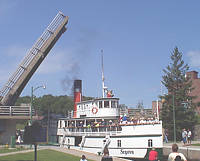 But,
no matter what season it is, there is no reason not to discover the
beauty of Port Carling. But,
no matter what season it is, there is no reason not to discover the
beauty of Port Carling.
Port Carling is located on Indian River, touching the shores of Silver
Lake and Mirror Lake. It is nestled between Lake Muskoka and Lake Rosseau,
along Hwy. 118. It is centred between Bracebridge and Bala, and has
access to Lake Joseph, Lake Rosseau and Lake Muskoka. Because of this
Port Carling has been dubbed, "Hub of the Lakes".It is also
a place to take a tour boat or watch the Segwun go through the locks
and the drawbridge, which is right in the centre of town. On even numbered
years it's the home of the Muskoka Lakes Association Antique Boat Show.
 The
beauty of the area fixated humans long before the first white settlers
made it their home, the original habitants even petitioned the government
to let them continue living there. It is no wonder why people continue
to travel from all over to visit, and make it their summer home. The
beauty of the area fixated humans long before the first white settlers
made it their home, the original habitants even petitioned the government
to let them continue living there. It is no wonder why people continue
to travel from all over to visit, and make it their summer home.
You can shop the stores (many located in old homes, each with their
unique styling and atmosphere) or visit the park, library or museum.
In the summer you can golf and in the winter there are hockey games,
curling and snowmobiling.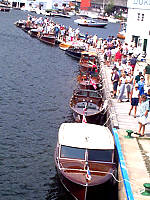
 Special
events throughout the summer include: the opening of the museum, Dinner
and Dance, Mayors Heritage Walk, the Music Festival, Gift and Craft
Show, a Corn Roast and Auction, the MLA Antique Boat Show, Water Ski
Show and Golf Tournaments. Special
events throughout the summer include: the opening of the museum, Dinner
and Dance, Mayors Heritage Walk, the Music Festival, Gift and Craft
Show, a Corn Roast and Auction, the MLA Antique Boat Show, Water Ski
Show and Golf Tournaments.
In the winter, when many older locals have left
for warmer climates, when the cottages have been closed for the summer
and when the museum is shutting down there are still many events happening
in the village. Some of these events are: a Thanksgiving Feast, Remembrance
Day Parade and service, Santa Skate, Christmas Dinner and Dance, Winter
Carnival and Skating Carnival. It is a great place to snowmobile to,
with the trail right along the main street (contact one of the snowmobile
associations to be sure of which side of the road to ride on).
For more information on events in Port Carling contact
the Township of Muskoka Lakes: 705-765-3156 or go to www.muskokalakes.ca
James
Bartleman
Note:
the following information was gleaned from James Bartleman's memoir
"Out
of Muskoka", published in 2002 by Penumbra Press
" Port Carling, however, never left me. The young man about to
embark on a
diplomatic career in July 1966 was not, of course, the half-breed child
who arrived in Port Carling nineteen years previously as part of a family
that was starting at the bottom of the Muskoka socio-economic and racial
hierarchy. I had changed and so had Port Carling."
Port Carling was the romping grounds for a young
James Bartleman, now (2004) the
Lieutenant Governor of Ontario. Bartleman is the second child of four
born to Percy Bartleman and Maureen Simcoe. His mother is an Ojibwa
Indian and spent springs and summers in the Indian Village on the Indian
River as a young girl. His father moved the family to Port Carling after
WW2. They started out their life in the village in a tent on a friend's
property, then in a rented summer cabin, until finally they bought
an abandoned home. His father worked as a labourer until becoming the
Lock
Master. Because of their white father, and the laws at the time, James,
his brother and sisters were not able to live on the reserve. Because
of their native mother they were subject to racial slurs and not accepted
readily into the community.
One summer while working for Robert Clause, a wealthy
American who cottaged on Black Forest Island, Lake Joseph he was given
the offer of a life time. Mr. Clause would pay for Bartleman to get
his grade 13 and, upon successful completion, his post-secondary education.
He went to the University of Western Ontario and took the four-year
Honours History Program. After completion he returned to do his graduate
work in their history department but left after a dispute over the thesis
topic.
From there Bartleman taught high school until he
had saved enough money to go to Europe. Once there he hitchhiked and
worked his way around, taking teaching positions and even worked as
a baker for a short period of time. He decided he wanted to join the
Foreign Service, early in his one-year European adventure. His decision
was made promptly while at the Canadian Embassy in Helsinki, Finland,
wiring his mother for money and being helped by a pretty french woman.
He returned to Ontario and to his teaching position for the 1965-66
school year, then wrote the exams for the Department of External Affairs.
With his career Bartleman has shaken many hands
in many different countries and played an intricate role in how Canada
is perceived by the rest of the world as an Ambassador, as Prime Minister
Chrétien's Foreign Policy Advisor and as the Assistant Secretary
to the Cabinet.
--------------------------------------
Question:
"How is Port Carling different now from when you were younger?"
Reply: "Well, it is busier. They moved the
IGA."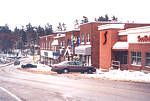
Writer in conversation with Almedia Brown,
89, president, Women's Auxiliary. November 2002.
"Port Carling may justly consider
itself the oldest community in Muskoka."
Richard Tatley, author Port Carling, the Hub of Muskoka Lakes.

Question: "How
has Port Carling changed over the years?"
Reply: "We had a school. It's the township
office now."
Writer in conversation with Elanor Andrew, 80. November 2002.
----------------------------------------------------
The
Beginnings of Port Carling
Once Port Carling was once called Obajewanung (or Obogawanung) which
means
"meeting place" in Ojibway. It is not known for sure, but
it is either the Ojibway Sandy Island Band (orginally from Georgian
Bay, but wintered on Tobin's Island), or the Muskoka Ojibwas, as they
became known after the Robinson-Huron Treaty of 1850, who settled there
about 1854 before going to Parry Island on Georgian Bay.
The Natives loved the area enough to petition the crown asking for Port
Carling ("3 miles by 6 miles") to be their reserve instead
of Parry Island. The petition was rejected and by 1870 the last Indians
left their homes, continuing to summer in the Indian Village, selling
trinkets to tourists, until the 1960s. Today it is known as the Indian
camp and is run jointly by the Chippewas and Mohawks.
After Port Carling was Obajewanung it was named
Indian Gardens or Indian
Village, depending on which account you read. In the mid-1800s the government
started to build Colonization Roads in the attempt to open Muskoka up
to settlers. The Free Grant Colonization Road, which ran from Washago
to the interior of Muskoka/Parry Sound, was built in 1859. This road
brought workers and pioneers to the area, though no one started to settle
in Port Carling until 1865, it is "the people who came between
1865 - 1900 (who) were the real pioneers."
Benjamin Hardcastle Johnston moved to the village
about 1866 and was appointed the first Post Master in 1868, a job he
held until his retirement in 1897. He saw the use of opening up a passageway
between to the two lakes and collected signatures in support of building
the locks. He, along with John Carling and A.P. Cockburn 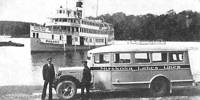 (owner
of Muskoka Navigation and Hotel Company), succeeded in convincing the
government of the worth of connecting the lakes. This may be the most
important moment in the history of the village. (owner
of Muskoka Navigation and Hotel Company), succeeded in convincing the
government of the worth of connecting the lakes. This may be the most
important moment in the history of the village.
The original Port Carling locks were
started in 1869 and completed in 1871. It allowed steamships to travel
freely between Gravenhurst and Rosseau, bypassing the Baisong rapids.
It also allowed The Muskoka Navigation and Hotel Company to expand its
fleet.  This
opened up Lake Rosseau and Lake Joseph to tourists going to resorts
and settlers to access their land which was part of the Free Lands Grant.
Port Carling itself gained, growing as workers and their families settled
in the village. This
opened up Lake Rosseau and Lake Joseph to tourists going to resorts
and settlers to access their land which was part of the Free Lands Grant.
Port Carling itself gained, growing as workers and their families settled
in the village.
A year which really stands out when reading the
history of Port Carling is 1871. This is the year the first resort was
opened, William Hanna started his business, and John Thompson decided
Steamboat Bay needed to be fortified.
Between 1871 and 1884 four resorts were opened in Port Carling and area,
serving a community of 200. Polar Star (1871) was first followed by
Ferndale House (1880), Vanderbugh House (1883) and Stratton House (1884).
The decade of 1870 also saw the three churches being
erected: 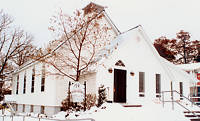 Port
Carling United Church (1872), Knox Presbyterian Church (1876) (photo)
and St. James Anglican Church (1875) (photo).
This decade saw two saw mills opening in response to the logging industry. Port
Carling United Church (1872), Knox Presbyterian Church (1876) (photo)
and St. James Anglican Church (1875) (photo).
This decade saw two saw mills opening in response to the logging industry.
 The
village's first sawmill was opened by Charles Vanderburgh, but was quickly
taken over by Joseph Sherwood Wallis in 1874, who ran it until the early
1900s. The second one was opened by the George and William Beasley ,
they sold it to John McDermott who kept it open until 1914. The
village's first sawmill was opened by Charles Vanderburgh, but was quickly
taken over by Joseph Sherwood Wallis in 1874, who ran it until the early
1900s. The second one was opened by the George and William Beasley ,
they sold it to John McDermott who kept it open until 1914.
The 1880s were the start of tourist based businesses
in Port Carling. Frederick Davenport Stubbs, came from Glen Orchard
and opened a store across from Interlaken Hotel (formerly Polar Star).
Originally a grocery store it quickly expanded and changed as he catered
to the tourists who had an 1/2 hour wait while steamships passed through
the locks. He ran his business until 1887.
The Orange Lodge seems to have had the largest social affect on the
town. The club, started by Roger Mahon and George Massey, built their
original lodge in 1872. The lodge closed down for a while but meetings
continued to be held in James Bailey's home till another lodge was built
in 1885 on Joseph Street. The group was reestablished under the name
Schomber Loyal Orange Lodge 685. The Orangemen were very-Protestant
and pro-British. According to Richard Tatley, "Port Carling was
becoming bright Orange, and very few Catholics ever settled there."
Dr. William Canniff was the first resident doctor
in 1895.
The boat business which was started in 1868 by William J. Johnston (son
of Benjamin Hardcastle Johnston), began to take off by the turn of the
century. His nephews invention of the Disappearing Propeller Boat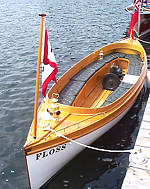 turned into The Disappearing Propeller Boat Company became the largest
company of its kind in Canada in 1922. Eventually this grew to be the
Port Carling Boat Works Limited.
turned into The Disappearing Propeller Boat Company became the largest
company of its kind in Canada in 1922. Eventually this grew to be the
Port Carling Boat Works Limited.
In 1896, the village wanted to be officially recognized
as more than a Post Office in Medora Township. During the winter of
1895-96 John McDermott (first reeve) and Joseph Wallis (became a councillor)
put out a petition, asking for official village status. They encouraged
the residents of Port Carling to go for village status by saying "they
were being short-changed by the Townships of Medora and Wood."
June 1896 the area was renamed and incorporated as a village. William
Hanna had petitioned to see the area named a town, while Benjamin Hardcstle
Johnston pushed for the title of village. Johnston was given the honour
of naming the village and calling it the village of Port Carling after
his friend John Carling, Minister of Public Works.
Churches
Port Carling United Church:
Originally Methodist, it was built in 1872 on land deeded to Rev. Lachlan
Taylor by the Crown. In 1925 it became United after a failed merger
with the Presbyterian Church.
Knox
Presbyterian Church:
Built in 1876. The first wedding held in this church was in 1914. The
land for this church was given by the Bailey estate. In 1925 they rejected
a merger with the United Church.
St. James Anglican Church:
Taking 10 years to complete, the building of this church was started
in 1875. The fist baptism was in 1881 with the first marriage in 1886.
Because of its proximity to the summer resort, Stratton House, the noise
would disrupt services. New land was purchased and the new church was
opened in 1912. The original burned along with Stratton House. The first
church was on property owned by Mr. Michael Bailey and the second location
was bought from the Roman Catholic Church.
Polar Star: Polar Star was the first resort to serve
in the Port Carling area, opened in the fall of 1871 by John Thomas.
In a few short years it had three name changes from Polar Star to Interlaken
in 1886 (by R.A. Arskey) and The Port Carling House in 1897 (Joseph
Ruddy).
Vanderburgh House: Charles Vanderburgh sold his store
(the Bay View House) in 1881 to William Hanna and built the Vanderbugh
House in 1883. He sold it in 1887 to Stephen Cope and left Port Carling
for good. It has gone by the name of London House while owned by Stephen
Cope. R.A. Arksey bought it in 1899 for use as a private home. John
Cope rented it in 1911 and renamed it Beverley House. Finally it went
by Beverley Beach Inn while owned by Thomas Pelletier.
Ferndale House: Ferndale House
was built in 1880. Opened by R.G. Penson it was located on Lake Rosseau.
The Nipissing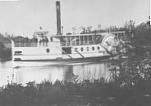 used to dock at the wharf every day. In 1895 he sold it to his son,
Seymour, an artist, who ran it till 1905. By 1887 there was an established
dance held every Friday night. Seymour tore down the original building
and replaced it with a new hotel which opened in 1899. From 1905 to
1910 John Cope rented it then George Penson operated it for two years.
It was a private home for four years until John Cope bought and ran
it for ten years. In 1926 it was sold to
used to dock at the wharf every day. In 1895 he sold it to his son,
Seymour, an artist, who ran it till 1905. By 1887 there was an established
dance held every Friday night. Seymour tore down the original building
and replaced it with a new hotel which opened in 1899. From 1905 to
1910 John Cope rented it then George Penson operated it for two years.
It was a private home for four years until John Cope bought and ran
it for ten years. In 1926 it was sold to
the Canadian Keswick, eventually becoming an interdenominational Bible
Conference Centre. It was destroyed by fire in 1945 but was rebuilt
with stone. In 1976 the Canadian Keswick went bankrupt. Today the property
is empty, but was purchased with the hope of becomming a resort once
again.
Stratton House: John Fraser and
wife Alexandrina ran it till John's death in 1902.
It burned in 1912 under the ownership of George Cannell.
Bay View House: Built by Charles Vanderburgh, William
Hanna bought it in 1881, owning it for 50 years. Sarah Hanna would board
the store clerks there. Before it burned in 1931 both Capt. William
McCully and John Cope operated it for a couple years each
---------------------------------------------
"It was a sad day when the Memorial
Centre was taken down."
Writer in conversation with Almedia Brown,
89, president, Women's Auxiliary, November 2002
Question:
"Did you take part in the Winter Carnival when you were a young
girl?"
Reply: "It was a skating carnival. Prizes
were handed out for best costume. The centre of the ice was decorated
to look like a winter scene. I won first prize one year as a Japanese
girl."
Writer in conversation with Alice Kenny, President - Sandford Women's
Institute. November 2002
"Not for
nothing was Port Carling known as the boat builders town."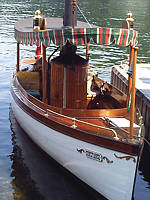
Richard Tatley, author of - Port Carling: Hub of the Lakes
"Early memories
of life in the summer in Port Carling Bay include the Sunday night services
held by Dr. Hughson and a congregation of rowboats and occupants around
the end of the the Port Carling dock."
Edwin Mills, author - Indian River Tales
"Two sawmills supply the people
with lumber, and the usual mechanics' shops are found, with the exception
of the shoemaker. There is a good opening here for some enterprising
son of St. Crispin."
John Denison, author - Micklethwaite's Muskoka
Question:
"Why did you move to Port Carling?"
Reply: "It was a good town to raise my family
in the Christian manner."
Writer in conversation with Larrie MacRae, 56, president - Royal Canadian
Legion, December 2002
------------------------------------------------
History
2
Port Carling has come full swing since its incorporation in 1896 which
made it more than just a Post Office in the Townships of Medora and
Wood. Port Carling is once again a Post Office location in a township,
this time it is the
Township of Muskoka Lakes, created in 1971.
It is a village full of dedicated people, who take pride in their community.
The village has a history of service groups helping wherever help is
needed and of people giving their all during W.W.I and W.W.II. They
did all this while learning how to have fun and etch a living in the
place they call home. From the first ship the village has opened their
streets to the people not lucky enough to live there year-round. This
practice did not stop with incorporation, it still continues today.
More hotels and resorts were opened after the turn
of the century running for a few years before their owners retired,
they burned, or like Shamrock Lodge, are still running today. 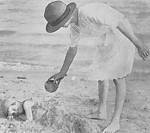 William
Foreman opened Endian Lodge just below Mirror Lake in 1901, running
it until 1912 when he sold for it $6,500. It changed hands a couple
of times before finally being bought by Rupert Duke and renamed Arcadia
Lodge. William's brother, Walter, turned his home into a small resort
in 1907, naming it Havington Farm, after "a place the Foreman's
had known in England." Riverdale House was opened by Richard C.
Harris, it was also a small resort opened out of his home. A similar
resort opened in the home of Ernest and Emma Duke called Shorehaven.
It opened in 1923. Alfred Edward Johnston turned his family farm into
Shamrock Lodge in 1934. William
Foreman opened Endian Lodge just below Mirror Lake in 1901, running
it until 1912 when he sold for it $6,500. It changed hands a couple
of times before finally being bought by Rupert Duke and renamed Arcadia
Lodge. William's brother, Walter, turned his home into a small resort
in 1907, naming it Havington Farm, after "a place the Foreman's
had known in England." Riverdale House was opened by Richard C.
Harris, it was also a small resort opened out of his home. A similar
resort opened in the home of Ernest and Emma Duke called Shorehaven.
It opened in 1923. Alfred Edward Johnston turned his family farm into
Shamrock Lodge in 1934.
The locks, which played an intricate role in the
growth of Port Carling, received a face lift between 1902 and 1903.
Built of concrete it was enlarged to 160 feet by 32 feet wide. This
was done to accommodate steamships at their height of use. During this
time local businessmen had to move their stores. Hanna and Sutton were
among them. The locks changed again in the 1920s when a small lock was
built into the dam for the use of private boats. This project was in
the works from 1921 to 1922.
The wooden bridge, spanning the Indian River was
replaced with a steel bridge, a two-year project started in 1921. It
was rebuilt again from 1973-75 to be a lift bridge.
With its location accessing three large lakes it is little wonder that
Port Carling had a large boat industry.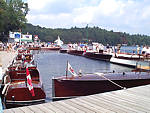 Locally invented and built boats have even been used by the Canadian
Navy and are the subject of books to this day.
Locally invented and built boats have even been used by the Canadian
Navy and are the subject of books to this day.
The village was growing and with size comes services.
The early 20th century brought Port Carling a tailor shop, and a hand-laundry
service (run by Lees Bing), a barber shop (Lee Wallace), drug store
and ice-cream parlours, a blacksmith, a master harness maker and a fish
hatchery (working to replenish the lakes after years of over fishing
from tourists). The Bank of Nova Scotia opened a summer branch in 1920,
" apparently responding to appeals from the boat building firms."
Along with those services, the village also supported two saw mills
which went out of business when the lumber men left.
In the 1950s Port Carling had acquired taxis, a
hardware store, electricians, a painting and decorating shop along with
a whole slew of business, some opened year round and others seasonal.
Around the turn of the century Port Carling had two water systems, one
for the south side and one for the northwest side of the bridge. This
was soon followed by electricity and the telephone.
Residents had more spare time now then ever before, allowing many different
recreational activities to start up. Boat racing became popular along
with ski jumping, hockey and curling.
An open air rink and a covered rink were in use
as early as the 1900s. The Palace Skating Rink, built at the location
of the present rink, was built in 1929.
The covered rink was quite unique, it was nick named Cedar Swamp because
of the five poles down the centre and gave the home team the advantage:
"This was rather an innovation for the time, and perhaps a measure
of goodwill by the owner, Captain Board. He built a covered rink behind
his sawmill in the early 1900s. The oddity of this rink was a series
of poles down the centre of the ice, which supported the roof. A quote
from a Toronto newspaper was to the effect that no team could beat the
Port
Carling boys, because they had become very adept at ricocheting the
puck off the posts, either to a team mate or to themselves." (Lloyd
G . Cope)
About 1906 Joseph Ruddy, owner of the Port Carling
House, opened a two-story drug store/ice cream parlour selling it to
John Whiting around 1911. The Toronto man , added a veranda and balcony
and hosted dances on the upper level every night when musicians were
available. Whiting also hosted a children's costume party every Thursday
night. He owned the business until 1953.
George Sutton's Meat Shop and Ice cream Parlour became the location
of the
Twenty-One Club after the fire of 1931. He had moved from the locks
to the main street location in 1907 and then sold in 1913.
During W.W.I and W.W.II local men signed-up while
the women started helping in any way they could. The Sandford Women's
Institute, celebrating 100 years in 2003, started knitting, sewing and
sending packages. During W. W. II they sent special packages to Tom
Temple and Lance Buttler who were P.O. Ws. After the Great Wars were
over, they were not forgotten. A Canadian Legion branch fought its way
into acceptance as a group , creating a cenotaph for their fallen comrades.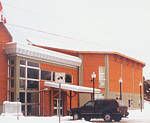 The Town Hall was turned into the Port Carling Memorial Community Hall
in remembrance to those who fought. The cenotaph graces the front yard
of the Port Carling Memorial
The Town Hall was turned into the Port Carling Memorial Community Hall
in remembrance to those who fought. The cenotaph graces the front yard
of the Port Carling Memorial
Community Centre. The Norma and Miller Alloway Muskoka Lakes Library

was built in the location of the Town Hall / Memorial Centre.
Every community has a story of a great fire, Port
Carling's took place during the nights of October 27 and October 28,
1931. The first night the Port Carling Boat Works burned to the ground,
the second night destroyed "Hanna's store .... the Bank of Nova
Scotia, the building being owned by Mr. George Sutton; Mr. Sutton's
Ice Cream Parlour, the Duke Motor Company Works, the Post Office, the
freight shed on Lock street, John Wallace's barber shop, George McCulley's
butcher shop, Victoria Hall, the Bay View House and Clark and Brown,
electricians, on Maple Street." By June of 1932 all but the Bay
View house had been rebuilt.
A volunteer fire brigade had been started in 1912
after the Stratton House fire but it wasn't until 1913 that council
ordered a fire engine which they sent back as unsatisfactory. The volunteer
fire brigade did have some hose, two extension ladders and fifty buckets.
Today Port Carling's Fire Department is one of 10 in the Township of
Muskoka Lakes.
The automobile changed the village again. Garages opened and the roads
were ploughed. Three garages were in the village by 1938. William Massey
built the first one in 1923 and named it the Port Carling Garage. This
was followed by Douglas Massey's Standard Garage in 1925 and Lorne Davidson's
Garage in 1932.
Today Port Carling has stores all along the main
street, a newly renovated rink, the main branch of the  Townships
libraries, the Township offices and a post office, along with all the
stores, restaurants and accommodations. The island Townships
libraries, the Township offices and a post office, along with all the
stores, restaurants and accommodations. The island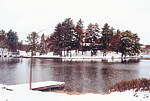 is now the home of the Muskoka
Lakes Museum. Though much has changed over the years one thing hasn't,
people still stop and watch as a steamship goes through the locks.
is now the home of the Muskoka
Lakes Museum. Though much has changed over the years one thing hasn't,
people still stop and watch as a steamship goes through the locks.
Some interesting dates on the side:
1917- Council regulated the speed of cars in the village and Joe McCulley
was the first person to plough the streets of Port Carling
1921 - The island was turned into a park. The "centre was leveled
for tennis courts and a bowling green, while a lock was built around
the outer perimeter."
1921- William Joseph Johnson rented out his building on the Island to
Grame Bell, for use as a motion picture theater.
1923 - Bill Massey bought the first motor car in the village and opened
the first garage, naming it Port Carling Garage.
1924 - Mrs. Hanna donated their property at the end of Bailey St. to
be used as a motor park. It is now Hanna Park.
1956 - There were nearly 30 business operating.
Service
Groups
The Hub Club: Started in 1954 by Mrs. Ed. Wilson with
the intention of reviving square dancing in the village. This club is
no longer in existence.
Loyal Orange Lodge No. 685: Started 1885 and again
in 1944. The Lodge sponsored Boys' Juvenile Lodge, Ladies Orange Lodge,
and Girls' Juvenile Lodge. The lodge is no longer running
Sandford Women's Institute: Started Aug. 10, 1903,
first to run the Winter Carnival and cater the Lion's dinners. With
13 members between the ages of 60 - 90 they will be celebrating their
100 birthday in 2003. Though not very active in the community the members
do still raise money for charities such as the OPP Food Drive.
Lions Club: November 21, 1945. Some things they do
include Organizing the Winter Carnival, hosting Thanksgiving Turkey
Diners, annual golf tournament. The club is still active in the village.
Canadian Legion Branch No. 529: Started Nov. 2, 1951,
became a Royal Canadian Legion in 1959. The group struggled for acceptance
in the village in the
early years. They were frowned on because their members drank while
the village was "dry". Then "with idle fingers and itchy
fingers," they started to help out in the community. Some things
they do include handing out student subsidies, helping with the hockey
clubs, hosting a Christmas Party and holding a flea Market in August.
The legion is still active in the village.
Ladies' Auxiliary of the Canadian Legion: Started May
6, 1955 it still runs today, though under the name of 50+ Club
Utilities
Electricity: The village set up electric street lights
in 1916, though they were only
allowed to be on from 5 or 7 pm to 10:30 pm. If the night was not very
dark they weren't turned on at all. By 1919 residences were having electricity
installed in their homes.
Water: The first was Water Works
Supply Company for those living on the south side. They supplied the
water by building a pump house above the dam. Some of the original shareholders
were the Hanna brothers, George Sutton, and Alex Cameron.
The brother's father, William Hanna, formed a water company for the
northwest side of the bridge. What became known as the Port Carling
Water Supple Company, started out with Hanna wanting water pumped into
his store so he built a water tower inside Johnston's fort, pipes were
laid and a pump house built at the base of Wallis Hill. These two utility
companies were merged in 1947.
Telephone: In 1897 William Hanna,
Post Master and Businessman, was made an agent with the Great North
Western Telegraph Company, allowing for messages to be
telegraphed out. The telephone took over the telegraph in 1902. the
Bracebridge and Muskoka Lake Telephone Company put poles and line up
in Port Carling in June. The first telephone was at the exchange office
in William Killen's house. The luxury quickly expanded to other business.
By 1923 there were seventy-three customers with the company.
Twenty-One Club: During the 40s
and 50s it was the "hot spot". Charlie and
Chuck Musgrave were the band with only a piano. People use to smuggle
in
their own booze because the town was 'dry' at the time. It was built
on the property of George Sutton's Ice Cream Parlor and Meat Market
which burned down in the 1931 fire. The Twenty-One Club's roof collapsed
in 1953 and the building was subsequently sold. Before being torn down
in 1984 it was used for a storage shed by Duke Boats .
School House: Schooling was started
in the late 1860s. The first school house was built about 1875 with
a larger, white brick, one built in 1896. The old one was rented back
from Joseph Wallis when there was need. The red brick school house was
built in 1906  after
the white brick one was destroyed by fire two-years previously. The
school house had four rooms, two were strictly public school with the
third, the grade eight room was partly high school. The fourth room
was strictly for high school students. They had a school fair which
included growing plants at home and marching to the town hall. Students
are now bussed to Glen Orchard and the school house is now the Township
Office. after
the white brick one was destroyed by fire two-years previously. The
school house had four rooms, two were strictly public school with the
third, the grade eight room was partly high school. The fourth room
was strictly for high school students. They had a school fair which
included growing plants at home and marching to the town hall. Students
are now bussed to Glen Orchard and the school house is now the Township
Office.
Boat Business: William Hanna rented
steam boats to use as supply boats starting in 1887, taking supplies
to the summer visitors. Henry Ditchburn (of Gravenhurst)
opened a boat livery at the upper end of the locks in 1897.
In 1898 William Joseph Johnston, added to his business and ran a boat
livery from underneath the Post office with the help of John Matheson.
He built the Dreadnaught and Fearnaught . His nephew, William J. Johnston,
Jr. helped out with the livery from the Port Sandfield side. While there
he built the Disappearing Propellor Boat,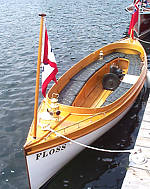 then turned it
then turned it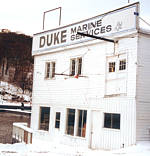 into a successful company named the Disappearing Propellor Company Limited
which had a factory on the Johnston property in Port Carling. The company
was liquidated in 1924, but Johnson, Jr. opened Port Carling Boat Works,
Limited the same year. Matheson who had helped Johnston, Sr. for a bit,
opened his own business in 1906. He sold his business to Ernest Greavette
and C.J. Duke in 1924 who renamed it Greavette and Duke. Greavette withdrew
and the company was renamed Duke Motor Service and then Duke Boats in
1931.
into a successful company named the Disappearing Propellor Company Limited
which had a factory on the Johnston property in Port Carling. The company
was liquidated in 1924, but Johnson, Jr. opened Port Carling Boat Works,
Limited the same year. Matheson who had helped Johnston, Sr. for a bit,
opened his own business in 1906. He sold his business to Ernest Greavette
and C.J. Duke in 1924 who renamed it Greavette and Duke. Greavette withdrew
and the company was renamed Duke Motor Service and then Duke Boats in
1931.
Reeves
(may not be complete)
John McDermott 1896-1900
W.H. Foreman 1900 - 1901
Robert Arksey 1901-
John Cope 1907
William Fredrick Hanna 1909
William Hanna 1914 -1919
John Cope 1929
John Wallace 1930
Hugh J. Carr 1932
Dr. Robert Ethelbert Joyce 1934
Allen Dixon (?)
George Blair 1943 - 1948
Arnold Stephen 1948
Robert Bennet (was in 1956, not sure when he started)
Port
Carling - Resources
- Bartleman, James - Out of Muskoka. Penumbra
Press, Canada, 2002
- Boyer, Barbaranne - Muskoka's Grand Hotels. Boston Mills Press. Erin,
Ontario. 1987
- Cope, Leila M. - A History of the Village of Port Carling. Hearld-Gazette
Press Bracebridge, Ontario. 1956.
- Cope, Lionel H. - Biographical Notes from the Past. Self-published.1992
- Denison, John. - Micklethwaite's Muskoka. Boston Mills Press, Erin,
Ontario.1993
- Judd,
Anne Duke. - Indian River Tales. Township of Muskoka Lakes. The Brucedale
Press, Port Elgin,1995
- Tatley, Richard. Port Carling - The hub of the Lakes. Boston Mills
Press. Ontario. 1996
- Various clippings from local newspapers.
Books on the local
history can be purchased at The Book Store on Joseph St. Port Carling.
It is open from May 15 to October 15. Phone 705-765-7222
--------------------------------------------
"Port Carling, one of the earliest settlement on the lakes,
is destined to become one of the most important, by reason of its central
location, the key of the three lakes; all whose business has to pass
its locks and all whose floating population in its excursion pass to
and from upon its river-lake." Toronto World, July 14, 1887.
Author John Denison thinks Frank Micklethwaites wrote the article.
---------------------------------------------
*Quick Facts:
Village Incorporated : 1896
Population of the Township of Muskoka Lakes (2002) - 6, 042
Churches - 3
Schools: 0
Mayor: Susan Pryke (Township of Muskoka Lakes)
Services: Muskoka Lakes Township Office, Library,
Post Office
Recreational: Community Centre, Arena, Hanna Park, Public Docks, Public
Locks, Public Beach, Public Hiking Trails, Port Carling Information
Booth (seasonal): 68 Joseph Street
Port Carling Business
Directory
Accommodations: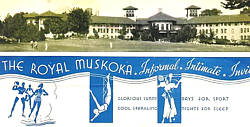
Muskoka
Accommodations Directory
Glenwood Park - 705- 765-3067
Sherwood Inn -705-765-6668
Clevelands House - 705-765-3171
Delta Lake Joseph - 705-765-2000
Pier 100 Cottage Resort - 705-765-2371
Shamrock Lodge - 705-765-3177
Real Estate
Muskoka Real
Estate Directory
Don
Evans - Royal Lepage
Murray
Lepard - Royal Lepage
Golf Courses in the area:
Kirrie Glen Golf Club (705) 645-4520
Clevelands House Golf Course (705) 765-3171
Diamond in the Ruff (705) 385-2222
Windermere Golf and Country Club (705) 769-3381
Snowmobile Clubs in the Region:
Muskoka Snowmobile
Region (705) 645-3123
Muskoka
Sno-Bombers (705) 645-2599
Muskoka
Lakes Snow Trails Association
Muskoka
Lakes Chamber
|


 The
beauty of the area fixated humans long before the first white settlers
made it their home, the original habitants even petitioned the government
to let them continue living there. It is no wonder why people continue
to travel from all over to visit, and make it their summer home.
The
beauty of the area fixated humans long before the first white settlers
made it their home, the original habitants even petitioned the government
to let them continue living there. It is no wonder why people continue
to travel from all over to visit, and make it their summer home.








 used to dock at the wharf every day. In 1895 he sold it to his son,
Seymour, an artist, who ran it till 1905. By 1887 there was an established
dance held every Friday night. Seymour tore down the original building
and replaced it with a new hotel which opened in 1899. From 1905 to
1910 John Cope rented it then George Penson operated it for two years.
It was a private home for four years until John Cope bought and ran
it for ten years. In 1926 it was sold to
used to dock at the wharf every day. In 1895 he sold it to his son,
Seymour, an artist, who ran it till 1905. By 1887 there was an established
dance held every Friday night. Seymour tore down the original building
and replaced it with a new hotel which opened in 1899. From 1905 to
1910 John Cope rented it then George Penson operated it for two years.
It was a private home for four years until John Cope bought and ran
it for ten years. In 1926 it was sold to











